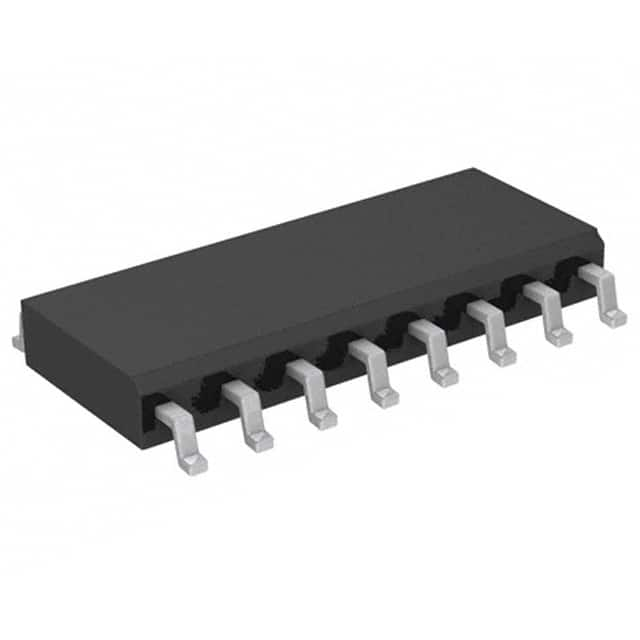Voir les spécifications pour les détails du produit.

74HCT238D-Q100J
Product Overview
Category
The 74HCT238D-Q100J belongs to the category of integrated circuits (ICs).
Use
This IC is commonly used in digital electronics for decoding and demultiplexing applications.
Characteristics
- High-speed operation
- Low power consumption
- Wide operating voltage range
- Schmitt-trigger action on all inputs
- Balanced propagation delays
- Symmetrical output impedance
Package
The 74HCT238D-Q100J is available in a small outline package (SO) with 16 pins.
Essence
The essence of this product lies in its ability to decode binary-coded inputs into one of eight mutually exclusive outputs.
Packaging/Quantity
The 74HCT238D-Q100J is typically packaged in reels or tubes, with a quantity of 2500 units per reel/tube.
Specifications
- Supply voltage: 2.0V to 6.0V
- Input voltage: -0.5V to VCC + 0.5V
- Output voltage: 0V to VCC
- Operating temperature range: -40°C to +125°C
- Maximum input current: ±1.0mA
- Maximum output current: ±25mA
Detailed Pin Configuration
The 74HCT238D-Q100J has 16 pins, which are labeled as follows:
- GND (Ground)
- A2 (Input A2)
- A1 (Input A1)
- A0 (Input A0)
- E1 (Enable Input 1)
- E2 (Enable Input 2)
- Y0 (Output Y0)
- Y1 (Output Y1)
- Y2 (Output Y2)
- Y3 (Output Y3)
- Y4 (Output Y4)
- Y5 (Output Y5)
- Y6 (Output Y6)
- Y7 (Output Y7)
- VCC (Supply Voltage)
- GND (Ground)
Functional Features
The 74HCT238D-Q100J offers the following functional features:
- Decodes three binary inputs into eight mutually exclusive outputs
- Enable inputs allow for easy expansion and cascading of multiple devices
- Schmitt-trigger action ensures noise immunity and improved signal integrity
- Balanced propagation delays ensure synchronized output signals
Advantages and Disadvantages
Advantages
- High-speed operation allows for efficient data processing
- Low power consumption reduces energy requirements
- Wide operating voltage range provides flexibility in various applications
- Schmitt-trigger action on all inputs enhances noise immunity
Disadvantages
- Limited number of input combinations due to the three-input design
- Requires additional external components for more complex decoding tasks
Working Principles
The 74HCT238D-Q100J works by accepting three binary-coded inputs (A2, A1, A0) and decoding them into one of eight mutually exclusive outputs (Y0-Y7). The enable inputs (E1, E2) control the operation of the decoder, allowing for easy expansion and cascading of multiple devices.
Detailed Application Field Plans
The 74HCT238D-Q100J finds applications in various fields, including: 1. Address decoding in microcontrollers and microprocessors 2. Memory selection in digital systems 3. Data demultiplexing in communication systems 4. Control signal generation in industrial automation 5. Display multiplexing in LED matrix panels
Detailed and Complete Alternative Models
Some alternative models that offer similar functionality to the 74HCT238D-Q100J include: 1. 74LS138 2. CD74HC238 3. SN74LS138 4. MC74HCT238A
These models can be considered as alternatives based on specific requirements and availability.
In conclusion, the 74HCT238D-Q100J is a versatile integrated circuit used for decoding and demultiplexing applications. Its high-speed operation, low power consumption, and wide operating voltage range make it suitable for various digital electronics projects. However, its limited input combinations and the need for additional components for complex decoding tasks should be taken into consideration.
Énumérez 10 questions et réponses courantes liées à l'application de 74HCT238D-Q100J dans les solutions techniques
Sure! Here are 10 common questions and answers related to the application of 74HCT238D-Q100J in technical solutions:
Q: What is the purpose of the 74HCT238D-Q100J? A: The 74HCT238D-Q100J is a 3-to-8 line decoder/demultiplexer IC used to convert binary information into multiple output lines.
Q: What is the voltage supply range for this IC? A: The 74HCT238D-Q100J operates within a voltage supply range of 4.5V to 5.5V.
Q: How many input lines does the 74HCT238D-Q100J have? A: This IC has three input lines (A0, A1, and A2) that determine the active output line.
Q: How many output lines can be generated by this decoder? A: The 74HCT238D-Q100J can generate up to eight output lines (Y0-Y7) based on the input combination.
Q: Can I use this IC for both decoding and demultiplexing applications? A: Yes, the 74HCT238D-Q100J can be used for both decoding and demultiplexing purposes depending on the application requirements.
Q: What is the maximum frequency at which this IC can operate? A: The 74HCT238D-Q100J has a maximum operating frequency of 70 MHz.
Q: Does this IC have any built-in protection features? A: Yes, the 74HCT238D-Q100J includes built-in diode clamps to protect against electrostatic discharge (ESD).
Q: Can I cascade multiple 74HCT238D-Q100J ICs to increase the number of output lines? A: Yes, you can cascade multiple ICs to increase the number of output lines by connecting the enable (E1, E2) and input (A0-A2) pins in series.
Q: What is the typical power consumption of this IC? A: The typical power consumption of the 74HCT238D-Q100J is around 10mW.
Q: Are there any specific precautions I should take while using this IC? A: It is recommended to follow proper static discharge precautions and ensure correct voltage levels are applied to prevent damage to the IC. Additionally, refer to the datasheet for detailed guidelines on usage and application-specific considerations.
Please note that these answers are general and may vary depending on the specific implementation and datasheet of the 74HCT238D-Q100J.

